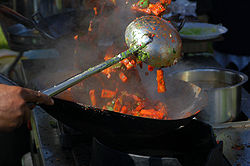- Stir frying
-
Stir frying is an umbrella term used to describe two Chinese cooking techniques for preparing food in a wok: chǎo (炒) and bào (爆). The term stir-fry was introduced into the English language by Buwei Yang Chao, in her book How to Cook and Eat in Chinese, to describe the chǎo technique.[1][2] The two techniques differ in their speed of execution, the amount of heat used, and the amount of tossing done to cook the food in the wok. Cantonese restaurant patrons judge a chef's ability to perform stir frying by the "wok hei" produced in the food. This in turn is believed to display their ability to bring out the qi of the wok.
Contents
Chao technique
The chao technique is similar to the Western technique of sautéing. A traditional round-bottom cast iron or carbon steel pan called a wok is heated to a high temperature. A small amount of cooking oil is then poured down the side of the wok (a traditional expression in China regarding this is "hot wok, cold oil"), followed by dry seasonings (including ginger and garlic), then at the first moment the seasonings can be smelled, meats are added and agitated. Once the meat is seared, vegetables along with liquid ingredients (for example often including premixed combinations of soy sauce, vinegar, wine, salt, sugar, and cornstarch) are added. The wok then may be covered for a moment so the water in the liquid ingredients can warm up the new ingredients as it steams off. To keep the meat juicy, usually a cook would take the seared meat out before vegetables are added, and put the meat back right before vegetables are done. In some dishes, or if the cooking conditions are inadequate, different components may be stir fried separately before being combined in the final dish (if, for example, the chef desires the taste of the stir fried vegetables and meats to remain distinct).
The food is stirred and tossed out very quickly using wooden or metal cooking utensils. Some chefs will lift the wok to the side to let the flame light the oil or add a dash of wine spirit to give the food extra flavor. Using this method, many dishes can be cooked extremely quickly (within a minute).
Some dishes that require more time are cooked by adding a few dashes of water after the stirring. Then the wok is covered with a lid. As soon as steam starts to come out from under the lid, the dish is ready. In this case, the food is stir fried on high heat for flavor and then steamed to ensure that it is fully cooked.
Bao technique
The wok is heated to a dull red glow. With the wok hot, the oil, seasonings, and meats are added in rapid succession with no pause in between. The food is continually tossed, stopping for several seconds only to add other ingredients such as various seasonings, broths, or vegetables. When the food is deemed to be cooked it is poured and ladled out of the wok. The wok must then be quickly rinsed to prevent food residues from charring and burning to the wok bottom because of residual heat.
The main ingredients are usually cut to smaller pieces to aid in cooking. As well, a larger amount of cooking fat with a high smoke point, such as lard and/or peanut oil, is often used in bao.
Footnotes
- ^ Chao 1945, pp. viii–ix “With the help of her daughter and her husband, who is an artist with the written word, she has created a new terminology, a new vocabulary, without which the art of Chinese cooking cannot be adequately introduced to the Western world. Some of the new terms like … ‘Stir-frying,’ … I venture to predict, will come to stay as the Chaos' contributions to the English language.” (from the Foreword by Hu Shih)
- ^ Chao 1945, p. 43 “Roughly speaking, ch'ao may be defined as a big-fire-shallow-fat-continual-stirring-quick-frying of cut-up material with wet seasoning. We shall call it ‘stir-fry’ or ‘stir’ for short. The nearest to this in western cooking is sauté. … Because stir-frying has such critical timing and is done so quickly, it can be called ‘blitz-cooking.’”
External links
Cooking techniques Dry ConductionConvectionRadiationWet High heatLow heatIndirect heatFat-based High heatBlackening · Browning · Frying (Deep frying · Pan frying · Shallow frying · Stir frying (bao)) · SautéingLow heatMixed medium Device-based Non-heat See also Categories:- Chinese cooking techniques
- Cooking techniques
Wikimedia Foundation. 2010.

